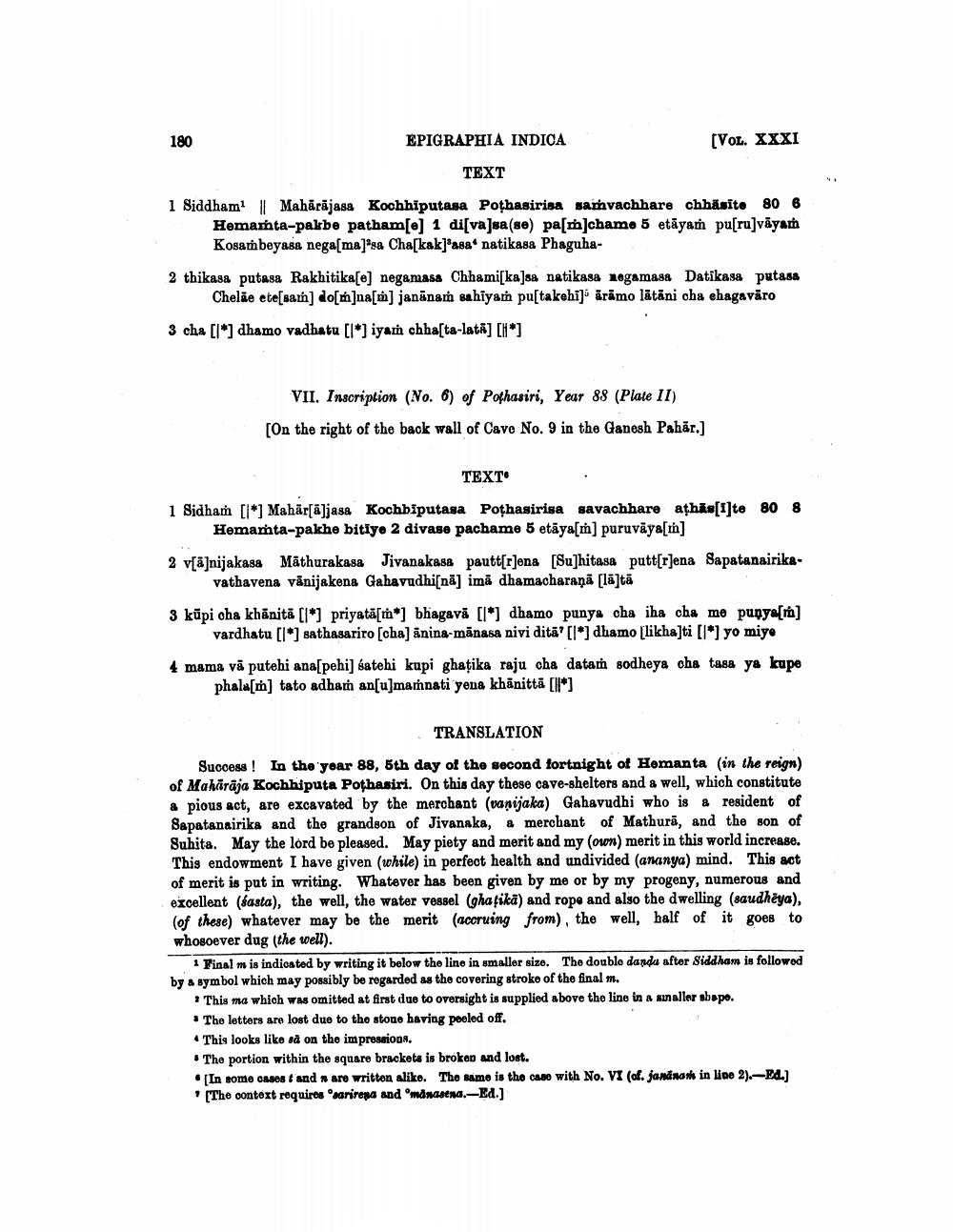________________
180
EPIGRAPHIA INDICA
(VOL. XXXI
TEXT
1 Siddham || Mahārājasa Kochhiputasa Pothasirisa samvachhare chhäsite 80 6
Hemamta-pakbe patham[e] 1 disva]sa (se) pa[m]chamo 5 etāyam pu[ru]vāyam
Kosambeyasa nega[ma]*sa Cha[kak]'asa natikasa Phaguha2 thikasa putasa Rakhitika[e] negamass Chhami[ka]sa natikasa nogamasa Datikasa patass
Cheläe ete[san] do[m]n[mi) janānam sahiyam pu[takehi] arāmo lātäni cha chagavāro 3 cha [l*] dhamo vadhatu [l*) iyan chha[ta-lata] [H*]
VII. Inscription (No. 6) of Pothasiri, Year 88 (Plate II) [On the right of the back wall of Cave No. 9 in the Ganesh Pahär.]
TEXT
1 Sidham [l*] Mahär[á]jasa Kochbiputasa Pothasirisa savachhare athis[]te 80 8
Hemanta-pakhe bitiye 2 divase pachame 5 etāya[m) puruvāya[in] 2 v[ājnijakasa Māthurakasa Jivanakasa pautt[r]ena [Su]hitasa putt[r]ena Sapatanairika
vathavena vånijakena Gahavudhi[nā] ima dhamacharaņā [la]tă 3 kūpi cha khānitā [l*) priyatā[m*] bhagavā [l*) dhamo punya cha iha cha me punya[mn]
vardhatu [l*) sathasariro [cha) Knina-mānasa nivi dita' [l*) dhamo (likha]ti [l*) yo miye 4 mama vā putehi ana[pehi] satehi kupi ghatika raju cha data sodheya cha tasa ya kupe
phala[m] tato adham an[u]mamnati yena khānittă [ll*)
TRANSLATION
Success! In the year 88, 5th day of the second fortnight of Hemanta (in the reign) of Mahārāja Kochhiputa Pothasiri. On this day these cave-shelters and a well, which constitute a pious act, are excavated by the merchant (vanijaka) Gahavudhi who is a resident of Sapatanairika and the grandson of Jivanaka, & merchant of Mathurā, and the son of Suhita. May the lord be pleased. May piety and merit and my (own) merit in this world increase. This endowment I have given (while) in perfect health and undivided (ananya) mind. This act of merit is put in writing. Whatever has been given by me or by my progeny, numerous and excellent (sasta), the well, the water vessel (ghafikā) and rope and also the dwelling (saudheya), (of these) whatever may be the merit (accruing from). the well, half of it goes to whosoever dug (the well).
1 Final m is indiosted by writing it below the line in smaller sizo. The double danda after Siddham is followed by a symbol which may possibly be regarded as the covering stroke of the final m.
This ma which was omitted at first due to oversight is supplied above the line in a munaller sbapo. • The letters are lost due to the stone having peeled off.
This looks like så on the impressioon. • The portion within the square brackets is broken and lost. . [In some cases and are written alike. The same is the case with No. VI (of. jananan in line 2).-24.) [The context requires sarirens and manasena.-Ed.)




